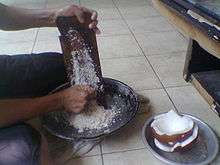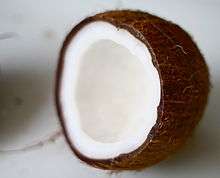Coconut milk
|
| |
| Region or state | Tropical region |
|---|---|
| Main ingredients | Coconut |
Coconut milk is the liquid that comes from the grated pulp of a mature coconut.[1] The opacity and rich taste of coconut milk are due to its high oil content, most of which is saturated fat. Coconut milk is a popular food ingredient used in Southeast Asia, South Asia, the Caribbean, and northern South America.
Definition
Coconut milk is distinguished from coconut water by its thicker consistency and milkier appearance. Unlike coconut water, which is the liquid found directly inside a coconut,[2] coconut milk is the result of crushing coconut meat.
Preparation

Coconut milk is traditionally made by grating the white inner flesh of a brown coconut and mixing the shredded coconut meat with a small amount of water in order to suspend the fat present in the grated meat.[1] The grating process can be carried out manually or by machine.[1]
Coconut milk has a fat content of up to 24%, depending on the fat level of the coconut meat and the quantity of added water.[3] Coconut milk exists in two grades: thick and thin. Thick coconut milk usually contains 20-22% fat while thin coconut milk usually contains 5-7% fat. Thick milk is prepared by directly squeezing grated coconut meat through cheesecloth. Thin milk is produced by soaking the squeezed coconut meat in water and further squeezing the meat until a thinner liquid forms. Thick milk contains soluble, suspended solids, which makes it a good ingredient for desserts and rich and dry sauces. Because thin milk does not contain these soluble solids, it is mainly used in general cooking. The distinction between thick and thin milk is not usually made in Western nations due to the fact that fresh coconut milk is uncommon in these countries and most consumers buy coconut milk in cartons or cans.
When refrigerated and left to set, coconut cream will rise to the top and separate out from the milk.[1] To avoid this in commercial coconut milk, an emulsifier and a stabiliser have to be used.[1]
Canned coconut milk
Manufacturers of canned coconut milk typically combine diluted and comminuted milk with the addition of water as a filler.[1] Depending on the brand and age of the milk itself, a thicker, more paste-like consistency floats to the top of the can and is sometimes separated and used in recipes that require coconut cream rather than coconut milk. Some brands sold in Western countries add thickening agents or emulsifiers to prevent the milk from separating inside the can.
Cuisine
Food

Coconut milk can be consumed on its own or as a milk substitute in tea, coffee, and baking. It is a common ingredient in many tropical and Asian cuisines for curries or other seasonings, meats, vegetables, garnishes, or desserts. Coconut rice is a rice cooked in coconut milk consumed in Southeastern Asia and the Caribbean. Nasi lemak is a Malaysian version of coconut rice, while the same dish is called nasi uduk in Indonesia. Coconut milk is also used throughout Asia for making traditional serabi, an Asian style pancake.
In Brazil, coconut milk is mostly used in northeastern cuisine, generally with seafood stews and desserts. In Colombia and Panama, the grated flesh of coconut and coconut milk are used to make sweet titoté. In Venezuela, meat dishes are prepared with coconut milk and shredded fish in a dish called mojito en coco. Coconut milk is used to make traditional Venezuelan dishes such as majarete, a typical Venezuelan dessert, and arroz con coco, also known as coconut rice.
Drink
In Southeast Asia, coconut milk is used to make many traditional drinks. Cendol is a popular iced drink from this region containing chilled coconut milk and green jellies made of rice flour. Coconut milk is also used in hot drinks, such as bandrek and bajigur, two popular drinks from Indonesia. Sweetened coconut milk and coconut milk diluted with water are two popular coconut beverages in southern China and Taiwan.
The jelly-like meat from the inside of the coconut is often added to coconut water to make a tropical drink. In Brazil, for example, coconut milk is mixed with sugar and cachaça to make a cocktail called batida de côco.[4]:183 Puerto Rico is also popular for tropical drinks containing coconut, such as piña colada and coquito, which typically contain coconut milk or coconut cream.
Nutrition
| Nutritional value per 100 g | |
|---|---|
| Energy | 962 kJ (230 kcal) |
|
5.5 g | |
| Sugars | 3.3 g |
| Dietary fibre | 2.2 g |
|
23.8 g | |
| Saturated | 21.1 g |
| Monounsaturated | 1.0 g |
| Polyunsaturated | 0.26 g |
|
2.3 g | |
| Vitamins | Quantity %DV† |
| Vitamin A equiv. |
0% 0 μg0% 0 μg |
| Thiamine (B1) |
3% 0.03 mg |
| Riboflavin (B2) |
0% 0 mg |
| Niacin (B3) |
5% 0.76 mg |
| Pantothenic acid (B5) |
4% 0.18 mg |
| Vitamin B6 |
2% 0.03 mg |
| Folate (B9) |
4% 16 μg |
| Vitamin C |
3% 2.8 mg |
| Vitamin E |
1% 0.15 mg |
| Vitamin K |
0% 0.1 μg |
| Minerals | Quantity %DV† |
| Calcium |
2% 16 mg |
| Iron |
12% 1.6 mg |
| Magnesium |
10% 37 mg |
| Manganese |
44% 0.92 mg |
| Phosphorus |
14% 100 mg |
| Potassium |
6% 263 mg |
| Sodium |
1% 15 mg |
| Zinc |
7% 0.67 mg |
| Other constituents | Quantity |
| Water | 67.6 g |
|
| |
| |
| †Percentages are roughly approximated using US recommendations for adults. | |
In a 100 milliliter (g) portion, coconut milk contains 230 kilocalories and is 68% water, 24% total fat, 6% carbohydrates, and 2% protein (see table). The fat composition includes 21 grams of saturated fat, half of which is lauric acid.[3]
Coconut milk is a rich source (20% or more of the Daily Value, DV) of manganese (44% DV) and an adequate source (10-19% DV) of phosphorus, iron, and magnesium, with no other nutrients in significant content (see table).
Health effects
One of the most prominent components of coconut milk is coconut oil, which many health organizations, such as the United States Food and Drug Administration,[5] World Health Organization,[6] International College of Nutrition,[7] the United States Department of Health and Human Services,[8] American Dietetic Association,[9] American Heart Association,[10] British National Health Service,[11] and Dietitians of Canada,[9] discourage people from consuming in significant amounts due to its high levels of saturated fat. Excessive coconut milk consumption can also raise blood levels of cholesterol due to the amount of lauric acid, a saturated fat that contributes to higher blood cholesterol by increasing the levels of high-density lipoprotein cholesterol.[12][13]
Horticulture
In 1943, it was discovered that coconut milk could actively encourage plant growth. Although there are many factors that attribute coconut milk to plant growth, the main cause is the existence of a cytokinin known as zeatin found in coconut milk. While the zeatin in coconut milk speeds up plant growth in general, it does not speed up growth in certain plants such as radishes.[14]:8 However, when 10% coconut milk is added to the substrate in which wheat is grown, substantial improvements have been noted.[15]
See also
References
- 1 2 3 4 5 6 "Coconut milk" (PDF). Philippine Coconut Authority. 2014. Retrieved 22 September 2016.
- ↑ Henni S (13 September 2010). "Coconut water". American Society for Nutrition. Retrieved 6 March 2017.
- 1 2 "Coconut milk, raw (liquid expressed from grated meat and water) per 100 g". Nutritiondata.com by Conde Nast; republished from the USDA National Nutrient Database, version SR-21. 2014. Retrieved 13 May 2016.
- ↑ Rexach, Nilda L. (1995), The Hispanic Cookbook (in English and Spanish), New York, NY, United States: Citadel Press, ISBN 9780806516011, retrieved 8 September 2012,
In New York, many New Yorkers use 12 yolks, canned coconut milk, condensed milk, and no salt, and use 1.51 proof rum.
- ↑ "Nutrition Facts at a Glance - Nutrients: Saturated Fat". Food and Drug Administration. 22 December 2009. Retrieved 16 March 2011.
- ↑ "Avoiding Heart Attacks and Strokes" (pdf). World Health Organization. Retrieved 6 April 2011.
- ↑ Singh RB, Mori H, Chen J, Mendis S, Moshiri M, Zhu S, Kim SH, Sy RG, Faruqui AM (December 1996). "Recommendations for the prevention of coronary artery disease in Asians: a scientific statement of the International College of Nutrition". J Cardiovasc Risk. 3 (6): 489–494. doi:10.1097/00043798-199612000-00002. PMID 9100083.
- ↑ "Dietary Guidelines for Americans 2010" (PDF). Department of Health and Human Services. Retrieved 17 March 2011.
- 1 2 "American Dietetic Association and Dietitians of Canada Offer Up-to-Date Guidance on Dietary Fat". American Dietetic Association. Retrieved 16 March 2011.
- ↑ "Tropical Oils". American Heart Association. Archived from the original on 2 June 2011. Retrieved 16 March 2011.
- ↑ "Lower your cholesterol". National Health Service. Retrieved 16 March 2011.
- ↑ Mensink RP, Zock PL, Kester AD, Katan MB (May 2003). "Effects of dietary fatty acids and carbohydrates on the ratio of serum total to HDL cholesterol and on serum lipids and apolipoproteins: a meta-analysis of 60 controlled trials" (pdf). Am. J. Clin. Nutr. 77 (5): 1146–55. PMID 12716665.
- ↑ Eyres L, Eyres MF, Chisholm A, Brown RC (2016). "Coconut oil consumption and cardiovascular risk factors in humans". Nutr Rev. 74 (4): 267–80. doi:10.1093/nutrit/nuw002. PMC 4892314. PMID 26946252.
- ↑ Mok, David W. S.; Mok, Machteld C. (1994). Cytokinins: Chemistry, Activity, and Function. CRC Press. ISBN 0-8493-6252-0.
- ↑ Bajaj, Y. P. S. (1990). Wheat. Springer. ISBN 3-540-51809-6.
External links

